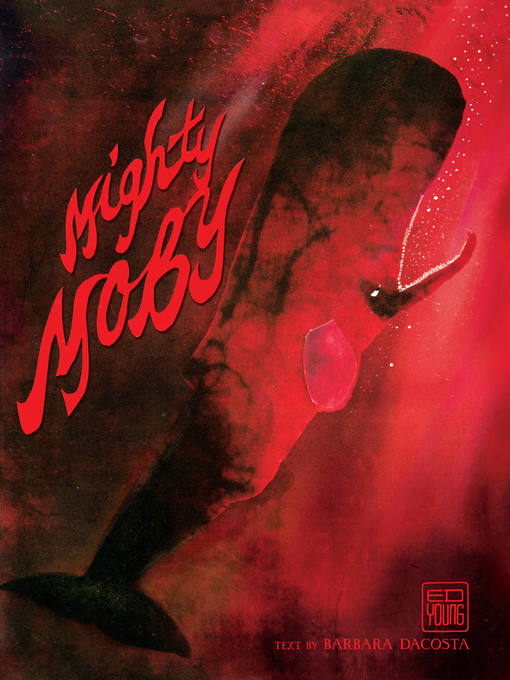
Mighty Moby
کتاب های مرتبط
- اطلاعات
- نقد و بررسی
- دیدگاه کاربران
نقد و بررسی

Starred review from June 1, 2017
Following Nighttime Ninja (2012), Young and DaCosta collaborate once again, this time infusing the sense and spirit of Moby-Dick (with a twist) into a picture book. As the book opens, a crew of whalemen longs to be homeward bound, their combined voices echoing sea chanteys (in fact all the words in the story but one are taken from Melville's novel). But the chase for Moby Dick is on, extending page after dramatic page...until the plug is pulled--literally--and readers realize that the story is an imaginative child's bathtub adventure. Each double-page spread (most in a typical horizontal orientation, others an unexpected vertical) brings readers a fresh dose of nuance and meaning created by Young's expert design and composition. The endpapers, which at first appear to be a random mottled tan and white, on closer inspection reveal possibly a negative image of sailing ships, or is it a whale's hide seen very close up? This illustrative complexity rewards readers who look deeply, engaging both their perceptions and emotions. Off-kilter lines indicate unease and tension. The red face of the peg-legged captain intent on revenge visually screams his anger. A harpoon's shocking pink line, at first glance incongruous, has a slant and color that reverberates against the cobalt blue of the water, creating a thrum of action. It all works. Stunning illustrations and authentic words grace this unusually sophisticated picture book. (Picture book. 5-10)
COPYRIGHT(2017) Kirkus Reviews, ALL RIGHTS RESERVED.

June 1, 2017
PreS-Gr 2-The book jacket depicting Herman Melville's infamous behemoth befits the epic adventure it heralds: blackness swallows the crimson light surrounding the whale, setting an ominous tone. In an author's note, DaCosta writes that every word comes from Moby-Dick except one. The text is minimal but dramatic, with dialogue as well as faux ballad and sea shanty verses. The story opens with three small silhouettes dancing to the lines, "Three long years we've been at sea, /Homeward bound we want to be." With the plot honed to its essence, the captain appears almost immediately, and the hunt ensues. Employing cut paper, photographs, string, and pastels, Young shifts between horizontal and vertical orientations; readers will turn the book accordingly. This adds energy to the already tumultuous collages created with strong diagonals, floating patterns, and contrasts in scale between humans and whale. While the captain's hat does emerge from the depths without him, and the sailors are tossed into the waves, a deus ex machina moment in the narrative makes this title an appropriate bath time tale. VERDICT Capturing the spectacle of the original and adding hints of humor may make this the preferred version of the classic for all ages. A masterpiece of bookmaking.-Wendy Lukehart, District of Columbia Public Library
Copyright 2017 School Library Journal, LLC Used with permission.

Starred review from October 16, 2017
DaCosta and Young pay spirited tribute to Moby-Dick, incorporating a twist that recalls their previous collaboration, Nighttime Ninja. In a closing note, they explain that the story began with Young’s dramatic mixed-media collages; DaCosta then crafted a text inspired by sea chanteys and using words from Melville’s text. “Three long years we’ve been at sea,/ Homeward bound we want to be,” sing three sailors at the outset, shown as dancing silhouettes against an expanse of black. After the whale is spotted, it engulfs the pages; it’s only seen in full as the sailors’ boats approach (“Row quiet... Row fast... Hold steady now—”) and the captain unleashes his harpoon. Young repeatedly shifts between vertical and horizontal layouts, forcing readers to turn the book as they turn the pages, evoking the churn of the sea and the violence of the struggle. The revelation that this man vs. nature conflict is being staged during a child’s bath—a giant photographic hand reaches in to pull the stopper on the drain—is a delight, and an ideal lead-in to the calming bedtime conclusion. Ages 4–8. Agent: Christa Heschke, McIntosh & Otis.

Starred review from November 15, 2017
Grades K-3 *Starred Review* What's this? Moby-Dick as a picture book? Well, not exactly; DaCosta has borrowed words from the Melville masterpiece (all but one word, to be precise) to create a pulse-pounding scene in which Captain Ahab spears the leviathan with his harpoon to no good effect. The whale dives into the deep, dark waters, dragging Ahab with him, but thenhold onto your watch caps, boyssurfaces like a mammalian earthquake! Will Ahab and crew best the beast, or will the massive Moby Dick defeat and destroy them? Before the question can be answered, a surprise is revealed: the sea story has been a tempest in a landlocked bathtub, a tale told by an imaginative parent to a little boy. Soon it's time for bed, matey, and a song to send the son off to sleep. The tale is ever engaging, but, oh, those illustrations by Caldecott medalist Young! Executed in various formsmixed-media collage using cut paper, photographs, string, and pastelthey spill across double-page spreads oriented both horizontally and vertically to give a sense of space and action. Words and images work together seamlessly to create a truly memorable reading and seeing experience. Melville would be proud and readers will be enchanted.(Reprinted with permission of Booklist, copyright 2017, American Library Association.)

























دیدگاه کاربران